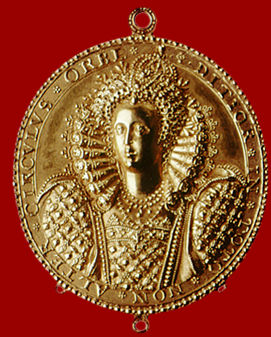ELIZABETH
I 0F ENGLAND AND THE ICONOGRAPHY OF MONARCHY
According to Roy Strong in Gloriana (1987),
“the deliberate development of state festivals in glorification of rulers,
the evolution of the palace as an architectural complex and the patronage
of humanist poets and historiographers” were all ways in which rulers in
early modern Europe consolidated their power and expanded the “Idea
of Monarchy”
Tudor
Iconography
- helped legitimatize dynasty and counteract criticism
of break with Rome
Henry
VIII commissioned Hans Holbein to paint royal
portraits; had round table at Winchester painted
with Tudor rose and colors
Edward VI and Mary
both had court painters (William Scrots
and Hans Eworth, respectively)
Elizabeth
I attempted to control production and distribution of royal portraits
- invoked not individual likeness but “abstract
principles of rule” (in neo-Platonist terms, “idea” or “form” of
kingship)
- served moral function:
portrayal of good ruler would encourage subjects to act virtuously 
- took place of religious icons
worship of Virgin Mary worship of Virgin Queen
lockets of Elizabeth worn like religious medals
symbols of sacred nature of royal person
1570s wearing of limnings of queen within jeweled
lockets became fashionable
- played part in international
politics
portraits of Elizabeth on continent often connected
with marriage negotiations
1579 was turning point in Elizabethan portraiture
- year of first allegorical portrait of queen
- connected with development of cult
of Virgin Queen and myth of Golden Age
- related to knowledge queen would not marry, expectation
of war with Catholic Spain, and growth of English maritime
imperialism
John Dee: Elizabeth should reassert dominion of world based
on imperial descent of Tudors from Brutus and on conquests of Arthur;
i.e. England's greatness would come not from marriage alliances
but through imperial conquests
- 1579 “Sieve” portrait by George
Gower combined imperial motifs with Petrarchan symbols of virginity
(story of Vestal Virgin Tuccia retold in Petrarch’s Trium ph
of Chastity). Sieve symbolized wisdom (Words on rim “A terra il ben mal
dimora insella”); painted at time of marriage negotiations with Alençon.
ph
of Chastity). Sieve symbolized wisdom (Words on rim “A terra il ben mal
dimora insella”); painted at time of marriage negotiations with Alençon.
Terrestial globe associated with imperial conquests (Duality of
concept of “body politic”: body of monarch represented realm; thus both globe
and Elizabeth represented England). “Sieve”
portrait by Cornelius Ketel adds pillar (jasper
column used by Petrarch to symbolize Laura’s chastity; Romans used columns to
celebrate imperial victories) and crown (of HRE)
 - “Ermine”
portrait of 1585 attributed to William Segar
also includes imperial and virginal themes. Sword of justice and olive branch
personify Elizabeth as “Peace”; ermine used by Petrarch to represent Laura’s
purity; topazes on collar symbolize resistance to lasciviousness
- “Ermine”
portrait of 1585 attributed to William Segar
also includes imperial and virginal themes. Sword of justice and olive branch
personify Elizabeth as “Peace”; ermine used by Petrarch to represent Laura’s
purity; topazes on collar symbolize resistance to lasciviousness
- “Ditchley”
portrait, painted by Marchus Gheeraerts the Younger
c. 1592, among the first to employ chiaroscuro (use of light and shade).
Commissioned by Sir Henry Lee to hang in his home in Ditchley, the painting
portrays Elizabeth as England (in her hair is armillary jewel)
Elizabeth’s cosmic powers were made her able to control
the weather (this was also shown by using the moon or by representing Elizabeth
as Diana/Cynthia, the Moon Goddess)
Elizabeth did not like paintings which showed her age
or physical decay. Her limner, Nicholas Hilliard,
was asked to create a formalized image of the queen  known
as the “mask of youth”
known
as the “mask of youth”
- “Rainbow”
portrait painted for Robert Cecil by Gheeraerts
c. 1600, employs “mask of youth”; dominant image is rainbow (symbol of peace);
cloak has “eyes and ears” to represent loyal ministers; sleeve has serpent with
heart pendant in mouth (showed wisdom to do right thing)
Elizabeth’s motto Semper Eadem
accorded well with the visual representation of stability and permanence
symbolized by her portraits
RETURN TO HIS 499 SYLLABUS
RETURN TO HIS 599 SYLLABUS

 ph
of Chastity). Sieve symbolized wisdom (Words on rim “A terra il ben mal
dimora insella”); painted at time of marriage negotiations with Alençon.
ph
of Chastity). Sieve symbolized wisdom (Words on rim “A terra il ben mal
dimora insella”); painted at time of marriage negotiations with Alençon.
 -
-  known
as the “mask of youth”
known
as the “mask of youth”